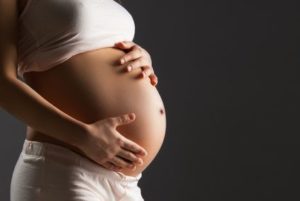 We all know that the mother’s diet can affect the health of her fetus. If the mother is sensitive to gluten and does not know it, there can be serious health repercussions for the unborn baby. For one thing, the birth weight is affected. Research appearing in the journal Human Reproduction (2010 Feb;25(2):528-34) looked at this issue. A total of 1,504,342 babies were born to 836,241 mothers during the study period. Of those, 1105 babies were born to women with diagnosed celiac disease and 346 were born to women with undiagnosed celiac disease. Women with untreated celiac disease delivered smaller babies and had a greater risk of having a VSGA (very small for gestational age–in the 5th percentile of birth weight) than women diagnosed with celiac disease who, avoiding gluten. Women with untreated celiac disease also had a higher risk delivering preterm.
We all know that the mother’s diet can affect the health of her fetus. If the mother is sensitive to gluten and does not know it, there can be serious health repercussions for the unborn baby. For one thing, the birth weight is affected. Research appearing in the journal Human Reproduction (2010 Feb;25(2):528-34) looked at this issue. A total of 1,504,342 babies were born to 836,241 mothers during the study period. Of those, 1105 babies were born to women with diagnosed celiac disease and 346 were born to women with undiagnosed celiac disease. Women with untreated celiac disease delivered smaller babies and had a greater risk of having a VSGA (very small for gestational age–in the 5th percentile of birth weight) than women diagnosed with celiac disease who, avoiding gluten. Women with untreated celiac disease also had a higher risk delivering preterm.
Another study, appearing in Gastroenterology (2005 Aug;129(2):454-63) had similar findings. A national register-based cohort study restricted to women aged 15-44 years with singleton live born infants was used. We identified 2078 offspring to women who had received a diagnosis of celiac disease (1964-2001): 1149 offspring to women diagnosed prior to birth and 929 offspring to women diagnosed after infant birth. Main outcome measures were: intrauterine growth retardation, low birth weight (<2500 g), very low birth weight (<1500 g), preterm birth (<37 gestational weeks), very preterm birth (<30 gestational weeks), and caesarean section. There was an association between undiagnosed celiac disease and a risk of intrauterine growth retardation, low birth weight, preterm birth and Caesarian section.
There may even be a connection between mental health and maternal gluten sensitivity. In a study appearing in The American Journal of Psychiatry (VOL. 169, No. 6, june 1, 2012), the authors analyzed archival dried blood spots obtained from newborns to assess whether levels of immunoglobulin G (IgG) directed at dietary antigens were associated with a later diagnosis of a nonaffective psychotic disorder. The study population consisted of individuals born in Sweden between 1975 and 1985 with verified register-based diagnoses of nonaffective psychoses made between 1987 and 2003 and comparison subjects matched on sex, date of birth, birth hospital, and municipality. A total of 211 case subjects and 553 comparison subjects consented to participate in the study. Data on factors associated with maternal status, pregnancy, and delivery were extracted from the Swedish Medical Birth Register. Levels of IgG directed at gliadin (a component of gluten) and casein (a milk protein) were analyzed in eluates from dried blood spots by enzyme-linked immunosorbent assay. Odds ratios were calculated for levels of IgG directed at gliadin or casein for nonaffective psychosis.
The authors found that of anti-gliadin IgG (but not anti-casein IgG) above the 90th percentile of levels observed among comparison subjects were associated with nonaffective psychosis (odds ratio=1.7, 95% CI=1.1–2.8). This association was not confounded by differences in maternal age, immigrant status, or mode of delivery. Similarly, gestational age at birth, ponderal index, and birth weight were not related to maternal levels of anti-gliadin IgG.






